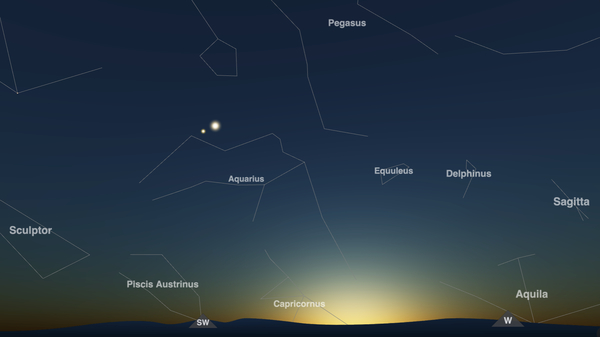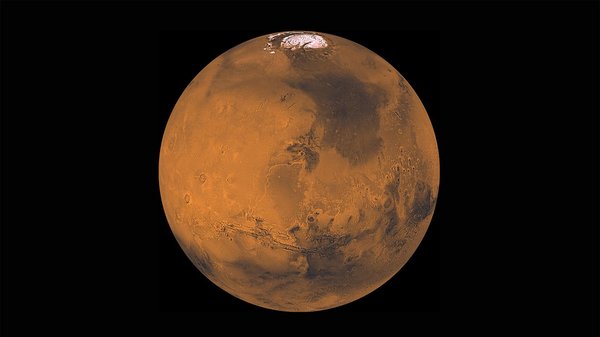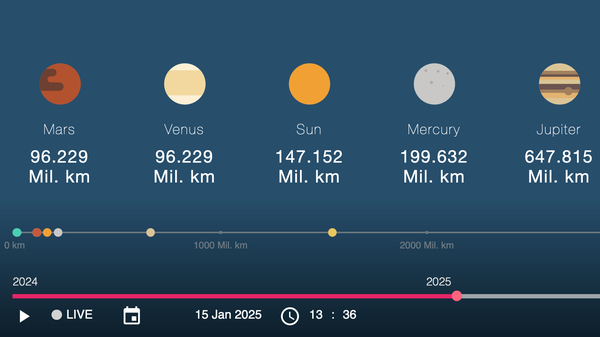January 2025: See the Planets at Their Best
Venus is at its farthest distance from the Sun in the evening sky, while Mars won’t be this bright again until February 2027. Also: Venus and Saturn have a close approach.


In this view from our Night Sky Map for New York at 5:30 pm (17:30) on January 18, 2025, bright Venus dazzles above the southwestern horizon. Just to its left is the fainter Saturn. (The size of objects on our Night Sky Map is slightly exaggerated to show their positions more clearly.)
©timeanddate.com
A Big Month for Planet Watchers
January 2025 is an ideal time to see Venus and Mars—but for subtly different reasons.
Meanwhile, Jupiter continues to be a dominating presence in the night sky, and Saturn has a close approach with Venus.
Find the planets on our Night Sky MapVenus at Greatest Elongation East
Venus orbits the Sun more closely than Earth does. As a result, Venus is never far from the Sun in our sky.
The best time to see Venus is around the time it appears at its maximum distance from the Sun. Astronomers refer to this as its “greatest elongation.”
Astronomical glossaryDuring the weeks around this date, Venus shines high above the western horizon at sunset, and does not set until well into the evening.
Venus will next reach greatest elongation east on August 15, 2026.
Astronomical calendarEastern Elongation, Western Horizon?
The description greatest elongation east can be a bit confusing because Venus appears in the western sky, near where the Sun sets. During this period, Venus is affectionately known as the “evening star.”
Nevertheless, Venus lies to the east of the Sun as the two objects cross the sky from the eastern horizon to the western horizon. This is why Venus sets after the Sun around the time of its eastern elongation.
Mars at Opposition

Mars’s reddish color comes from particles of rust (iron oxide) in its dusty surface.
NASA/JPL/USGS
Unlike Venus, Mars orbits the Sun less closely than Earth does. Consequently, Mars can be either close to the Sun in our sky, or far away.
The most favorable time to see Mars is when it is directly opposite the Sun in the sky—astronomers call this its “opposition.”
In the weeks around opposition, Mars is at its brightest, and its reddish color is particularly noticeable with the naked eye.
Mars will next reach opposition on February 19, 2027.
Our Planetary Neighbors
One of the reasons why Venus and Mars can shine so brightly in our sky is that their orbital paths around the Sun are relatively close to Earth’s.
Their actual distance from Earth changes continuously as each planet travels along its orbit at different speeds.
Go to our planet tool and select “Distance from the Earth”At the beginning of January 2025, Mars was the closest planet to Earth; on January 15, Venus will become Earth’s nearest neighbor.


As this screenshot from our planet tool shows, Mars and Venus will be at the same distance from Earth at around 13:36 UTC on January 15, 2025. Roughly speaking, 96 million kilometers is 60 million miles—about two-thirds of the distance from Earth to the Sun.
©timeanddate.com
Jupiter Brighter than Mars
However, even when it is at its 2025 opposition, Mars is outshone by another planet: Jupiter.
Go to our planet tool and select “Brightness”The following table gives the brightness of the planets at 01:00 UTC on January 16.
The brightness of an astronomical object is called its magnitude. The lower the number, the brighter the object—and in the case of very bright objects, the number can go below zero.
Brightest Planets on January 16, 2025
Why is Jupiter so bright? It’s not because Jupiter is close: on January 16, it will be nearly 7 times farther away from us than Mars.
The reason is that Jupiter is big. The actual diameter of Jupiter is about 21 times bigger than the diameter of Mars. Even when seen from Earth, the apparent size of Jupiter in the sky will be 3 times bigger than Mars on January 16.
Go to our planet tool and select “Size in the Sky”Saturn Meets Venus in the Sky
What about Saturn? Its actual diameter is only slightly smaller than Jupiter’s. However, Saturn is about twice as far from Earth as Jupiter, and therefore appears less bright.
One of the notable things about Saturn this January is that it lies close to Venus in the sky.
How close is this? Hold your hand against the sky at arm’s length: the width of your little finger is about 1°.
A handy guide to measuring the sky

On January 18, 2025, Venus and Saturn will be within around 2.17° of each other in the sky—roughly twice the width of your little finger held at arm’s length.
In summary, January 2025 is a great month for getting outside, looking up at the night sky, and enjoying the wonders of our solar system.